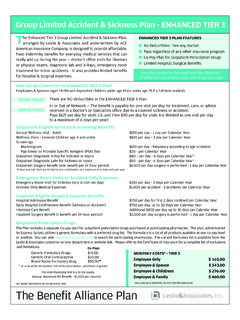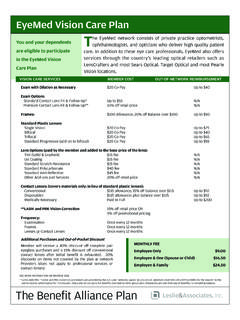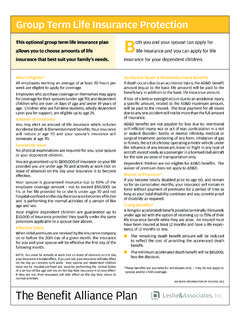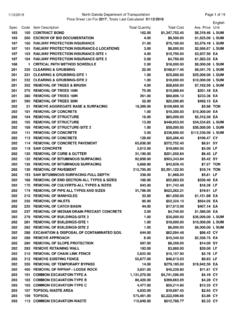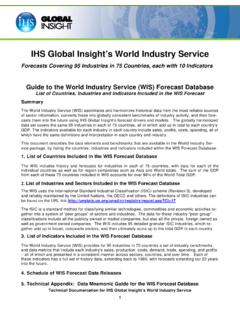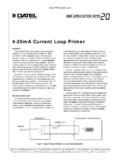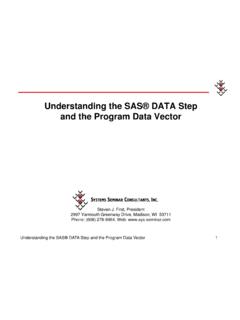Transcription of Group Critical Illness Insurance Plan T - …
1 KEY BENEFITSn First occurrence benefit lump sum benefits payable upon initial diagnosis of a covered Illness or Additional occurrence benefit if an insured collects full benefits for a Critical Illness under the plan and later has one of the remaining covered illnesses or procedures, the policy will pay the full benefit amount for any additional Illness . Occurrences must be separated by at least 6 months (benefits cannot be paid twice for the same Critical Illness ).*n Child coverage at no additional cost each dependent child ages 0-19 (22 if full-time student) is covered at 10 percent of the primary insured amount at no additional Featuresn Your Choice of Benefit Amounts Benefit amounts available from $5,000 to $50,000 for Employees ages 18-69 and Spouses ages 18-64.
2 (Spouse benefit amount not to exceed employee benefit amount.) n Lump-sum Benefit Benefits are paid directly to the insured following the diagnosis of each covered Critical Illness . Use your lump-sum benefit any way you see fit there are no Limited Underwriting Approval is based on answers to simple medical questions contained on the application Portable Coverage Keep the plan if you leave your job for any Health Screening Benefit This benefit pays up to $50 per year for tests such as mammography, colonoscopy, chest x-ray, cholesterol test, and pap smear.
3 **COVERED Critical Illness Percentage of Face Benefits are payable upon diagnosis of the following Critical illnesses Amount PayableHeart Attack (Myocardial Infarction) 100%Coronary Artery Bypass Surgery 25%Stroke 100%Major Organ Transplant 100%Renal Failure (End Stage) 100%Cancer 100%Carcinoma in situ 25% This plan is limited benefit supplemental coverage and is not intended as a substitute for medical Insurance * Coverage may be continued until benefits have been paid in full for each covered Illness .
4 ** Please refer to the certificate for a complete list of tests. Group Critical Illness Insurance PlanThe Benefit Alliance PlanSEE MORE INFORMATION ON REVERSE SIDEL eslie&Associates, Group Critical Illness plan, underwritten by Continental American Insurance , an AFLAC company, is designed to help you and your family cope with and recover from the financial stress of surviving a Critical Illness or condition. The good news is that many people with Critical Illness survive these life-threatening battles.
5 Unfortunately, as the recovery process begins, people become aware of the bills that have piled up. According to the 1998 Heart and Stroke Statistical Update by the American Heart Association:STATISTICS n 66% of heart attack victims survive at least one year or longer. The death rate from heart attacks has declined more than half over the last 40 75% of stroke victims live at least one year following the stroke. The stroke survival rate has nearly tripled since 40% of life-threatening cancer patients beat the disease and are alive five years from diagnosis.
6 NON-SMOKER MONTHLY PREMIUMS AGE $5,000 $10,000 $15,000 $20,000 $25,000 $30,000 $35,000 $40,000 $45,000 $50,000 18-39 $ $ $ $ $ $ $ $ $ $ 40-49 $ $ $ $ $ $ $ $ $ $ 50-54 $ $ $ $ $ $ $ $ $ $ 55-59 $ $ $ $ $ $ $ $ $ $ 60-64 $ $ $ $
7 $ $ $ $ $ $ 65-69 $ $ $ $ $ $ $ $ $ $ MONTHLY PREMIUMS AGE $5,000 $10,000 $15,000 $20,000 $25,000 $30,000 $35,000 $40,000 $45,000 $50,000 18-39 $ $ $ $ $ $ $ $ $ $ 40-49 $ $ $ $ $ $ $ $ $ $ 50-54 $ $ $ $ $ $ $ $ $ $ 55-59 $ $ $ $ $ $ $ $ $ $ 60-64 $ $ $ $ $ $ $ $ $ $
8 65-69 $ $ $ $ $ $ $ $ $ $ Organ Transplant Means undergoing surgery as a recipient of a transplant of a human heart, lung, liver, kidney, or Infarction (Heart Attack) Means the death of a portion of the heart muscle (myocardium) resulting from a blockage of one or more coronary arteries. Heart attack does not include any other disease or injury involving the cardiovascular system. Cardiac Arrest not caused by a myocardial infarction is not a heart attack.
9 The diagnosis must include all of the following criteria: 1). New and serial Electrocardiographic (EKG) findings consistent with Myocardial Infarction; and 2). Elevation of cardiac enzymes above generally accepted laboratory levels of normal [in case of creatine physphokinase (CPK), a CPK-MB measurement must be used]. 3). Confirmatory imaging studies such as thallium scans, MUGA scans, or stress ecocardiograms. 4). Chest Means Apoplexy (due to rupture or acute occlusion of a cerebral artery), or a cerebral vascular accident or incident, which is first manifested on or after the policy date.
10 Stroke does not include Transient Ischemic Attacks and attacks of Verterbrobasilar Ischemia. We will pay a benefit for Stroke which produces permanent clinical neurological sequela persisting for at least 30 days following an initial diagnosis made after any applicable Waiting Period. We must receive evidence of the permanent neurological damage provided from Computed Axial Tomography (CAT scan) or Magnetic Resonance Imaging (MRI). Stroke does not mean head injury, transient ischemic attack or chronic cerebrovascular Means a malignant tumor characterized by the uncontrolled growth and spread of malignant cells and the invasion of distant tissue.



